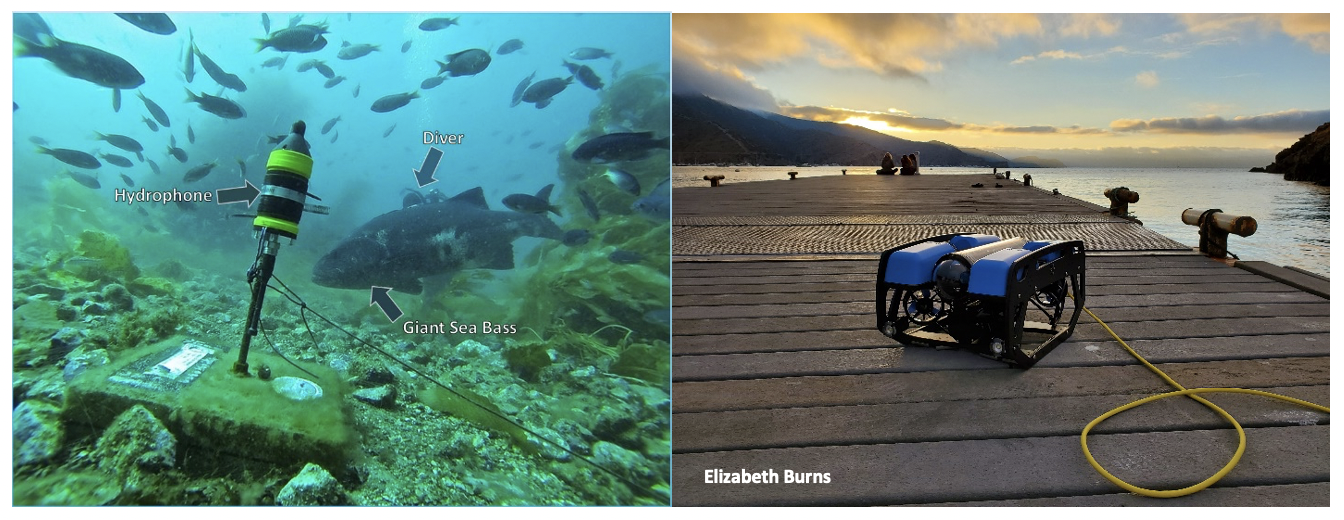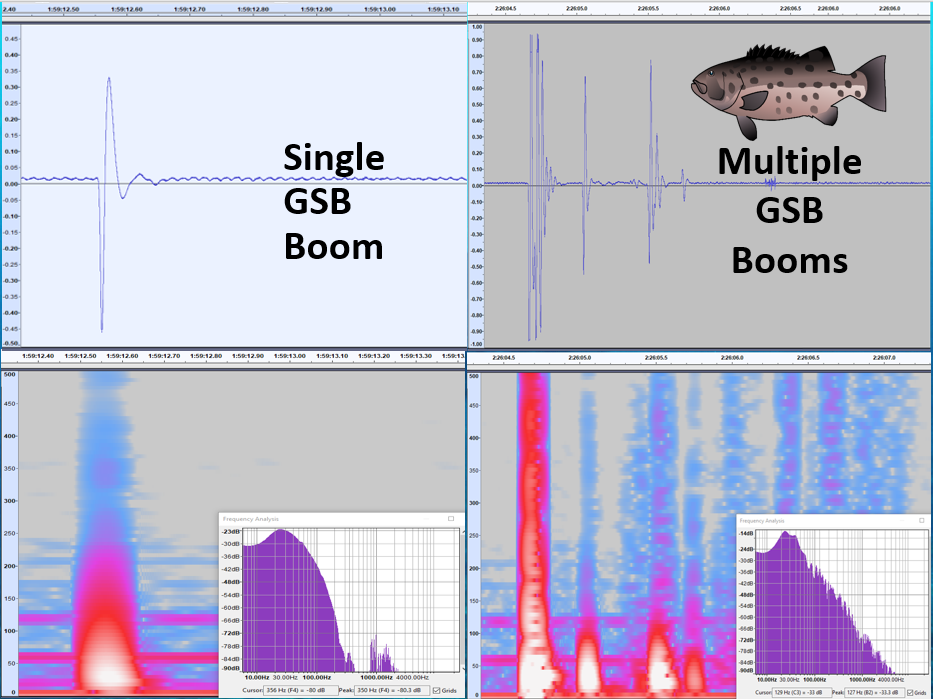By: Elizabeth Burns
Hi, my name is Elizabeth! I am entering my third year of my master’s program at California State University, Northridge and this is my second year as a Summer Wrigley Fellow at Catalina Island. I have the pleasure of researching Giant Sea Bass’ courtship behaviors and sound production during their spawning. If you’ve never heard of Giant Sea Bass, you wouldn’t be the first. The Giant Sea Bass (fig 1) is the apex predator of the California kelp forest, research has shown that these fish can live over 76 years of age, grow over 800 pounds, and can reach lengths over 7 feet. Unfortunately, we know very little about these fish, due to the severe overfishing they experienced since the early 1900’s. Giant Sea Bass are still feeling the effects of this bottle neck and are listed as critically endangered on the IUCN’s red list.

Figure 1 Photos Left: From SCIF Archives, 6 Giant Sea Bass caught at Santa Catalina Island. Right: Photo of three Giant Sea Bass courtesy of Michael Couffer.
Due to increasing efforts and protection measures over the years, Giant Sea Bass populations are slowly on the rise making it easier to study them. This has allowed us to uncover some of the secrets these giants still hide. Recent research has shown that a substantial population of Giants congregate every summer at Santa Catalina Island to spawn. Little is known about what happens in Giants’ spawning aggregations besides the fact that they are used for spawning. My research focuses on two of the biggest mysteries of the Giant Sea Bass, their courtship behaviors and sound production during spawning. These are behaviors that have not been properly described or documented before. I believe that that Giant’s produce sound and perform courtship behaviors in order spawn. Understanding these behaviors and how Giant Sea Bass reproduce are crucial to helping conserve their species.
Video on size difference of adult and juvenile Giant Sea Bass (by Elizabeth Burns):
Divers that have had the pleasure of swimming with Giant Sea Bass will sometimes get to hear the sounds giants make. We think Giants make 2 different sounds to communicate with each other. There is a sort of standard “Boom” to alert other fishes and organisms to their presence and a “snare drum” like sound for reproduction to entice the ladies. Not only do we believe that male Giants “boom” for their ladies, but they also dance with them. Giants start their courtship behavior at sunset and continue into the early morning. Observing these behaviors requires diving, specialized under water microphones, and underwater video equipment which are items I have. Unfortunately, this summer I was unable to go out into the field and deploy my cool equipment (fig 2). Normally I would be out on boats cruising around the island placing underwater microphones (hydrophones) at spawning aggregations sites. The hydrophones would record sounds in the evening continuously at spawning sites. While I would use my ROV, remote operated vehicle submersible, named Bruce to video record courtship dances with his mounted camera.

Figure 2: Left: Hydrophone placed at sample sight in 2014 – 2015. Right: Photo of Bruce on the dock at Wrigley, taken by Elizabeth Burns.
Fortunately, this summer I was given a chance to examine Giants’ spawning aggregations sound data that was gathered by my lab’s alumni and past Wrigley fellows from 2014 – 2015. Which is still a very difficult task, for one we don’t know for certain what a boom always sound like or look like. When I examine the sound data not only do I listen to sound clips recorded, I also visually examine them using spectrograms (fig 3). Spectrograms allow you to visually see signal strength, or “loudness”, of a sound at various frequencies represented as a waveform. These spectrograms allow me to visually quantify the decibels and frequencies of the sounds recorded (fig 3).

Figure 3: Left: Video of a miscellaneous sound recorded by hydrophone sampling for Giant Sea Bass sounds by Elizabeth Burns. Right: Four images of Giant Sea Bass sounds identified. Top images are wave forms of Giant’s booms and below are the spectrogram of the waveforms.
Spotting and identifying Giant booms can be tricky. The hydrophones don’t just pick up Giants sounds but also other fish, shrimp, divers, boats, and other various ocean sounds, as you can see here:
Another obstacle that makes going through this data rather difficult, is the constant reminder of Catalina. When I listen to my sound data, I’m reminded about how much I miss being out at Wrigley and researching on campus. I miss learning and interacting with all the fellows, researchers, and guests that come to Wrigley. I cannot wait to hopefully come back next year and finish my research next summer. Until then, I’ll be listening to ocean sounds and thinking of Wrigley fondly.

